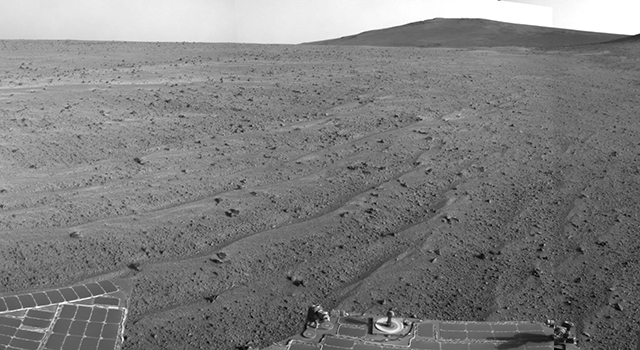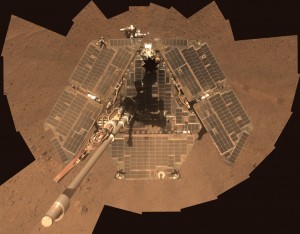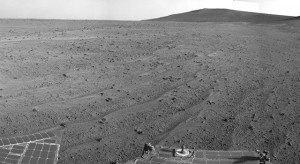September 1, 2014 – A labour of love is about to be carried out by the Jet Propulsion Laboratory (JPL) involving Opportunity, the ten-year veteran Martian rover. It seems fitting to write about this on Labour Day as the rover continues to set new records for distance and longevity on the Martian surface.
Opportunity (its self portrait seen in the image above) has been showing signs of senility at age ten. That’s because the outdated processor and flash memory contained in its computer has been well used with the memory overwritten many times. This is leading to many failed sectors in the flash memory and these need to be isolated and avoided in the future.
As evidence the JPL team has had to perform dozens of resets of the rover’s main computer system for gathering data and pictures from Mars, and every reset occupies a day or two making Opportunity less useful as a research outpost, and more a tottering patient enduring continuous health maintenance and monitoring.
So NASA and JPL have decided to wipe Opportunity’s flash memory clean and reformat it. Now I have reformatted my hard drives (not flash memory) here in my home office, but never have I had to try doing this to a drive 200 million kilometers (125 million miles) away. Reassuringly John Callas of JPL points out that “the flash reformatting is a low-risk process, as critical sequences and flight software are stored elsewhere in other non-volatile memory on the rover.”
Reformatting is planned for this month with the JPL team currently downloading all useful data from the rover to save it. JPL slowed data transmission rates to ensure accurate information transfer. All this is being performed on a system that we would consider positively archaic today. The onboard computer’s main chip is an IBM 20 Megaherz RAD6000 RISC processor. This would be state-of-the-art for the mid 1990s, not 2014.
Flash memory is small, a piddly 256 Megabytes. I have an SD memory card that I took out of my two-year old digital camera last week with 1 Gigabyte of storage. A 40 Gigabyte SD memory card sells for as little as $40 Canadian in stores today. Too bad we can’t FedEx or UPS one up to the remarkable rover to keep it doing its thing. But this JPL operation is at least an opportunity to keep Opportunity going possibly for many more years to come.
So far Opportunity and its now lifeless sister rover, Spirit, have made some amazing discoveries including:
- a better understanding of the dynamics of Martian atmosphere including its composition and the role wind and dust play in shifting the landscape.
- dust devils in action.
- water both evident from the past and present.
- meteorites lying in plain sight on the surface.
- evidence of a past, early in the planet’s history, when surface conditions were habitable.
- and a breathtaking array of pictures and accumulated data that astronomers and planetary scientists will be studying for years.
Seems fitting, therefore, to talk about this on Labour Day with a team working hard here on Earth to help a tiny robot sent to the surface of Mars.





















